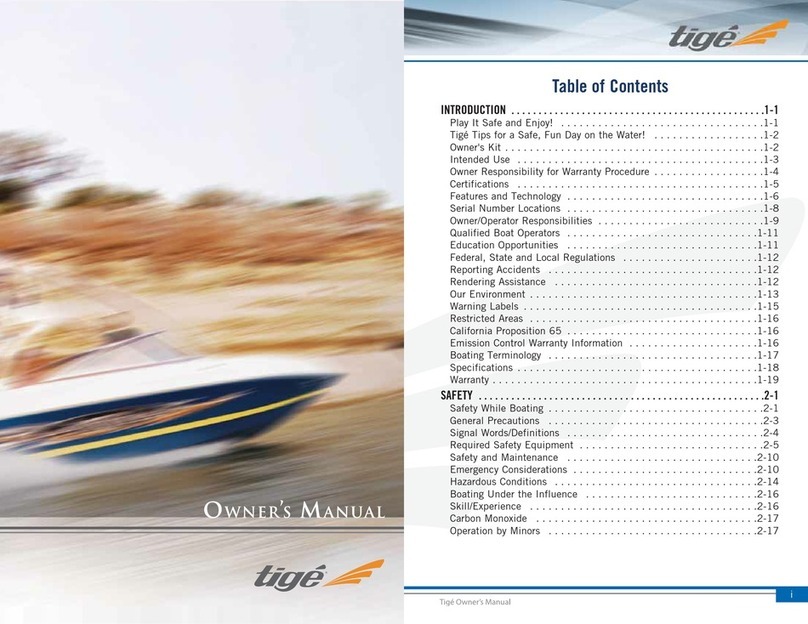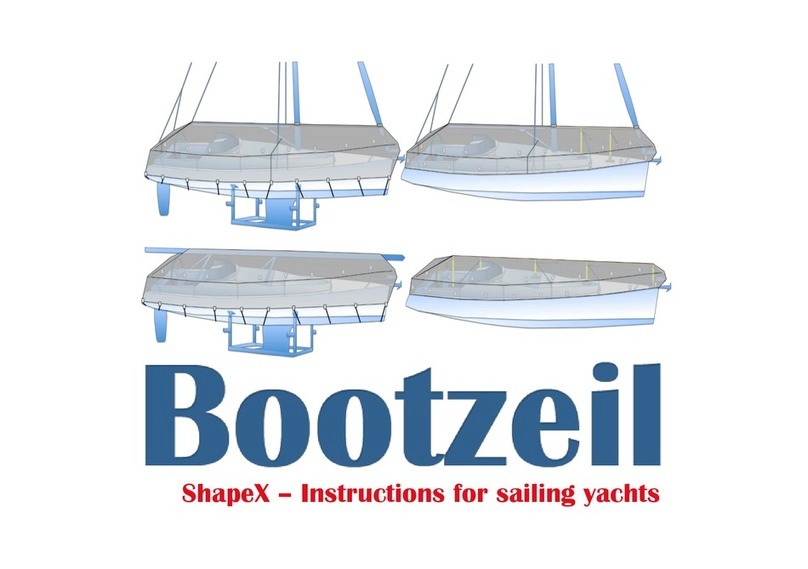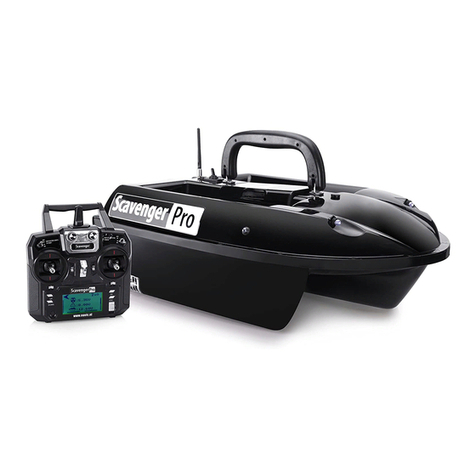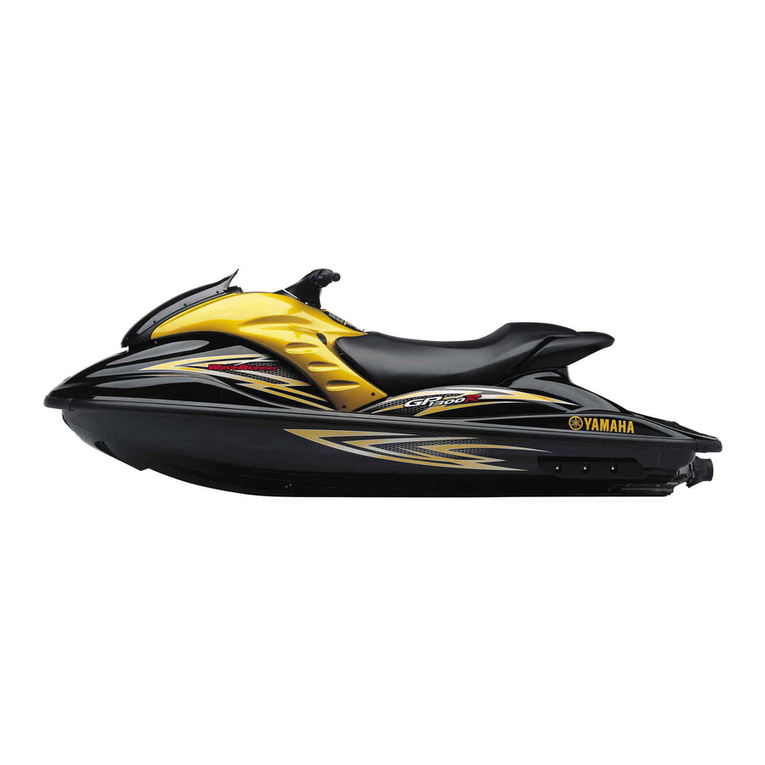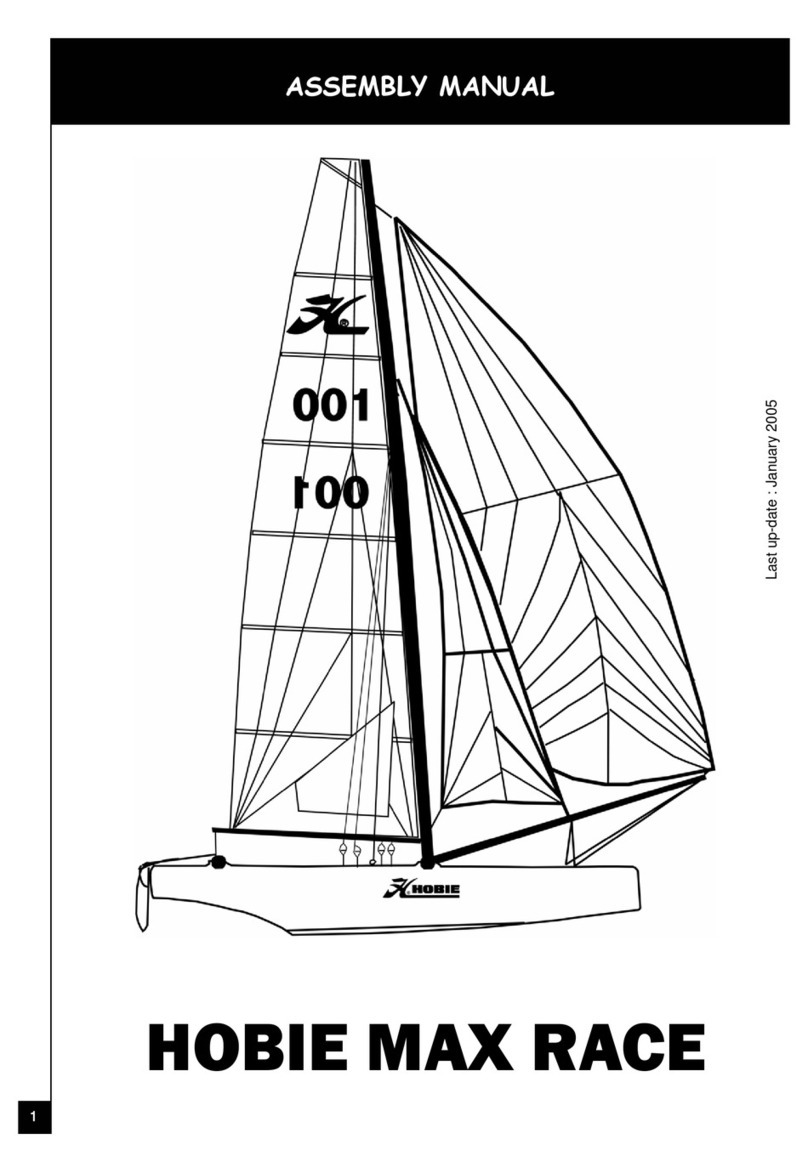Tige 2015 ASR User manual

2015
OWNER MANUAL

ii
TABLE OF CONTENTS
INTRODUCTION.......................................................... 1-1
Play It Safe and Enjoy!..............................................1-2
Tigé Tips for a Safe, Fun Day on the Water! ..............1-3
Owner’s Kit..............................................................1-3
Intended Use ...........................................................1-4
Owner Responsibility for Warranty Procedure ............1-4
Certifications ...........................................................1-5
Features and Technology ..........................................1-6
Serial Number Locations ...........................................1-8
Owner/Operator Responsibilities .............................1-10
Qualified Boat Operators ........................................1-11
Education Opportunities.........................................1-12
Federal, State and Local Regulations .......................1-12
Reporting Accidents ...............................................1-13
Rendering Assistance .............................................1-13
Our Environment....................................................1-14
Warning Labels ......................................................1-16
Restricted Areas .....................................................1-17
Boating Terminology ..............................................1-17
Standard Seating Chart ..........................................1-18
European Seating Chart .........................................1-19
360 Service Plus / Warranties ..................................1-20
SAFETY ................................................................2-1
Safety While Boating................................................2-1
Develop Water Sense ...............................................2-1
Watersport Responsibility Code ................................2-2
General Precautions .................................................2-2
Boat Safety Labels....................................................2-3
Safety Statements ....................................................2-4
Warning and Instructions .........................................2-6
Boating Regulations .................................................2-7
Boater Responsibilities..............................................2-8
Registration ...........................................................2-11
Education Opportunities.........................................2-12
Insurance...............................................................2-12
Operation By Minors ..............................................2-14
Passenger Safety ....................................................2-14
Overloading...........................................................2-15
Visibility.................................................................2-17
Boating Under the Influence ...................................2-18
Reporting Accidents ...............................................2-19
Rendering Assistance .............................................2-19
Factory Provided Safety Equipment .........................2-20
Owner Provided Safety Equipment ..........................2-21
Life Saving Equipment............................................2-21
Navigation Lights ...................................................2-23
Horn or Whistle .....................................................2-23
Fire Extinguisher.....................................................2-23
Emergency Safety Lanyard ......................................2-24
Visual Distress Signals ............................................2-25
Recommended Safety Equipment............................2-26
Emergencies ..........................................................2-27
Warning Markers ...................................................2-32
Carbon Monoxide ..................................................2-33
Watersport Safety ..................................................2-38
General Watersport Precautions..............................2-40
Watersports Safety Code ........................................2-44
Basic Rules on the Road..........................................2-48
Aids to Navigation .................................................2-48
USWMS System .....................................................2-49
FWMS ...................................................................2-50
Types of Buoys .......................................................2-51
FWMS Marking System...........................................2-51
Uniform State Regulatory Markers ..........................2-52
FEATURES .................................................................. 3-1
Dash Panels .............................................................3-1
General Layouts/Storage...........................................3-3
Switches, Controls, Ports, Gauges and Indicators.......3-4
Controls ..................................................................3-9
Ports .....................................................................3-12
Gauges..................................................................3-12
Circuit Breaker Panel ..............................................3-16
Fuses.....................................................................3-16
Cockpit and Exterior...............................................3-17
Convex VX Installation ...........................................3-26

TABLE OF CONTENTS
CARE AND MAINTENANCE........................................ 6-1
General Maintenance Interior .................................. 6-2
Interior ................................................................... 6-3
Bilge Pump and Bilge Area....................................... 6-6
Exterior................................................................... 6-7
Gelcoat Maintenance .............................................. 6-8
Stainless Steel and Chrome.................................... 6-10
Propeller............................................................... 6-12
Saltwater Boating ................................................. 6-13
Battery Maintenance ............................................. 6-14
Transmission Oil Level Inspection............................ 6-16
Steering................................................................ 6-17
Unscheduled Maintenance .................................... 6-18
Slinging/Lifting the Boat ........................................ 6-20
Storage/Winterization ........................................... 6-22
SERVICE REQUIREMENTS.......................................... 7-1
WARNING LABEL APPENDIX ..................................... 8-1
OPERATION .............................................................. 4-1
Getting Underway................................................... 4-1
Preflight Checklist ................................................... 4-1
Fueling ....................................................................4-4
Shifting/Running ..................................................... 4-5
Steering.................................................................. 4-6
Stopping ................................................................ 4-6
Docking.................................................................. 4-7
Starting .................................................................. 4-9
TAPS² Operation ................................................... 4-10
Water Sports Settings............................................ 4-12
Tigé Speedset® Cruise Control Operations............. 4-14
Troubleshooting .................................................... 4-17
Safety Equipment.................................................. 4-17
Boarding............................................................... 4-18
Boat Loading ........................................................ 4-18
Running ............................................................... 4-19
Maneuvering Techniques ....................................... 4-19
Salt Water ............................................................ 4-21
Freezing Temperatures........................................... 4-21
Towing Procedure ................................................. 4-21
Anchoring ............................................................ 4-22
Performance Boating............................................. 4-24
Propellers ............................................................. 4-25
BOAT SYSTEMS .......................................................... 5-1
Steering.................................................................. 5-2
Engines .................................................................. 5-2
Transmissions.......................................................... 5-3
Strut and Bearing.................................................... 5-4
Electrical System ..................................................... 5-4
Fuel System ............................................................ 5-5
Ballast Tank System (optional).................................. 5-5
Bilge Systems.......................................................... 5-6
Shower System ....................................................... 5-7
Schematic and System Illustrations........................... 5-9
iviii

SECTION 1

Congratulations on your purchase of a Tigé, the world’s
most unique multi-sport inboard! We’re confident you
will enjoy Tigé’s extraordinary blend of world-class water
sports performance, incredible versatility and outstanding
user convenience.
Before using your new Tigé, we encourage you to thoroughly
review this owner’s manual and familiarize yourself with
your boat’s operational and safety features.
We have made every effort to ensure the accuracy of this
manual, providing the most current information available.
Since we are continuously refining features and design,
Tigé periodically makes changes to models, systems and
specifications. These changes are included in an updated
online version of this owner’s manual available at
www.tigé.com.
If you have any questions concerning your new Tigé or
this manual, please contact your Tigé dealer. Once again,
thanks for choosing Tigé. Have a great time!
PLAY IT SAFE AND ENJOY!
Safety is a top priority in the design and construction of
every Tigé boat. Before use, we strongly encourage owners
and operators to become familiar with Tigé safety features,
safe operation, maintenance procedures and overall safe
boating practices. In addition to ensuring your safety and
that of your passengers, proper maintenance and operation
of your Tigé greatly enhance your enjoyment on the water.
1-2
INTRODUCTION

TIGÉ TIPS FOR A SAFE, FUN DAY ON THE WATER
A day on the water may be relaxing for you, but cruising
through chop, towing skiers and other normal boating
activity puts significant stress on a boat. Although your
Tigé is built tough to withstand the rigors of on-water
activities, you should check and tighten pylons, towers,
accessories and other attachments every time you go out
to avoid injury and ensure safe reliable performance. It is
also very important to regularly check and maintain the
various systems and equipment on your boat before you
get underway.
To help you keep everything in good working order, refer
to the Preflight Checklist in Section 4 each time you go
boating. Make it a habit and you’ll make the most out of
your time on the water.
OWNER’S KIT
The Owner’s Kit contains the owner’s manual and may
include other information about accessories or components
offered with your Tigé boat. This information is provided by
the manufacturers of those products and should be read,
kept and referred to whenever you are using the accessory
or component, or before you put it into use. Refer to
these manufacturers’ manuals for additional operation and
maintenance instructions not covered in this manual.
Owner’s Manual
The owner’s manual contains information concerning
the operation and care of your boat. The descriptions
contained within the manual will introduce you to features
of Tigé and provide you the general knowledge of how the
boat works. Become familiar with the information in each
section before you use your boat.
INTRODUCTION
1-3
SECTION 1
Even if everything has been planned and designed for
the safety of the boat and its users, boating is still highly
dependent on the weather conditions, water conditions,
and the experience of you and your passengers. One can
never ensure full safety. It is your responsibility as the owner
or user to know the boat’s equipment, capabilities and
intended use. The specific information on the operation
of the equipment and systems on your boat should be
supplied by that manufacturer. Read, understand and keep
all the information supplied, and familiarize yourself and all
users with the boat before you put it into use.
INTENDED USE
Your Tigé boat is intended for use as a pleasure and sport
craft and a Craft Design Category of:
Inshore – Category C
Craft designed to operate in winds up to Beaufort force
6 and the associated wave heights and significant wave
heights up to 6’6.7” (2 m). Such conditions may be
encountered in exposed inland waters, in estuaries, and in
coastal waters in moderate weather conditions.
OWNER RESPONSIBILITY FOR WARRANTY PROCEDURE
Before Operating
Before operating your new Tigé boat, it is necessary that
you read and understand this manual and the warranty,
and that you take the time to read about other accessories
or components offered with your Tigé boat.
1-4

Warranty Service Requirements
All Tigé warranty service must be completed by an
Tigé Dealer. If you are not able to return your boat to
your dealership, contact them so they can assist you in
coordinating the warranty service. Any claims against Tigé
Boats without prior approval from Tigé Boats on repairs
completed by an unauthorized dealership may be denied.
If You Sell Your Tigé Boat
Your warranties are transferable. If you choose to sell your
Tigé boat to anyone other than a Tigé Dealer, contact Tigé
Boats for the appropriate warranty transfer information:
www.tigé.com or 325.676.7777. If the transfer procedures
are not followed, future warranty service may be denied.
CERTIFICATIONS
National Marine Manufacturers Association (NMMA)
Tigé Boats is a member of the NMMA. This independent
organization’s members include boat, engine and marine
equipment manufacturers that are focused on the
improvement and safety of boating.
Your new Tigé boat is NMMA certified. An NMMA
certification not only satisfies the U.S. Coast Guard
(USCG) regulations but also the more rigorous equipment
and system standards based on those established by the
American Boat and Yacht Council, Inc. (ABYC). Your Tigé
boat meets or exceeds NMMA safety-based certifications.
INTRODUCTION
1-5
SECTION 1
Engines
Our engine manufacturer works closely with Tigé to ensure
that its engines deliver maximum performance, reliability
and customer satisfaction. Part of this commitment is a
certification program that provides Tigé dealers and service
technicians with ongoing training and information about
our engines. Certified engine service personnel must attend
periodic service schools held at the Tigé headquarters.
The training includes review of all manufacturing and
installation processes, proper servicing procedures as well
as existing and developing engine technologies.
FEATURES AND TECHNOLOGY
Convex V Hull/Apex Hull/TAPS²
The unique, patented shape of the Tigé Convex V hull, and
Apex Hull combined with TAPS² technology are key Tigé’s
superior multi-sport versatility, incredible performance and
unmatched ride. All other inboard hulls curve down with a
“hook” toward the transom and must rely on heavy ballast
or drag hardware to produce even entry-level wakeboarding
wakes. The Convex V and Apex hulls curves up in a
rocker shape like a wakeboard or slalom ski. Tigé uses its
breakthrough TAPS² technology to control hull running
attitude and wake characteristics. At wakeboarding speed
with TAPS² in the up position, the bow rises and the Convex
V & Apex hulls settles naturally, creating tremendous water
displacement and huge world-class wakes without ballast
or drag hardware. A push of a button adjusts TAPS² down,
lowers the bow and creates instant planning and slalom
type wakes.
1-6

Ride, handling and fuel efficiency are also dramatically
enhanced, allowing Tigé to deliver outstanding overall
performance unmatched by any other inboard.
Tigé SpeedSet
Available as an option on all Tigé models, Tigé SpeedSet
is the most advanced precision digital speed control in the
marine industry. It is also the easiest to use. The SpeedSet
control panel incorporates Touchpad and Touch Screen
Recognition for easy fingertip use without taking your eyes
off the waterway. SpeedSet readouts are displayed on the
heads-up digital monitor located on the dash, as well as our
Touch Screen. For added safety, the SpeedSet control panel
is conveniently located adjacent to the throttle for quick,
easy access with your throttle hand. SpeedSet operation is
precise, multi-functional and simple. You can even preset
a preferred speed and precisely hit that speed set after set.
Perfect double-ups and consistent towing speeds are now
at your fingertips.
Advanced CAN bus Technology
TEC (Tigé Electronic Control) components are in constant
communication with the engine’s computerized ECM using
advanced MEFI-5 electronics. State-of-the-art CAN bus
technology allows components to communicate hundreds
of times a second over a simple, reliable, two-wire system.
Keeping the juice flowing and the electronics humming is
our Central Electronic
Distribution Center (CEDC), which increases electrical system
reliability and efficiency through circuit simplification and
load management. CEDC also stabilizes electrical output
throughout the boat, significantly reducing power spikes.
INTRODUCTION
1-7
SECTION 1
Product Improvement
Because of Tigé’s commitment to continuous product
improvement, the illustrations used in this manual may
not exactly match your boat and are intended only as
representation for reference views. Some illustrations may
also show optional accessories, which may or may not be
available for your boat. Some optional accessories can
only be installed at the time the boat is manufactured and
cannot be installed by your dealer. Your dealer can help
with any questions you may have on options, which can be
added to your boat.
SERIAL NUMBER LOCATIONS
Your Tigé boat, its engine, propulsion unit and other
equipment onboard are identified with a serial number.
These identification numbers associated with your boat
are extremely important. Prepare a list of all serial number
items and store it in a safe place other than onboard the
boat. Refer to the equipment operator’s manuals supplied
in your owner’s kit for location of serial numbers.
1-8

Record these numbers below.
Hull Identification Number (HIN):
Located at the top, right (starboard) corner of the transom.
HIN: ______________________________________________
Ignition Key, a key tag, is also provided with the keys; store
tag or destroy.
Key Number: ______________________________________
Registration Number/State: __________________________
Date of Purchase: __________________________________
Dealership Name and Address: _______________________
_________________________________________________
__________________________________________________
Phone: ___________________________________________
Salesperson: _______________________________________
Engine:
Engine Serial Number: ______________________________
Engine Manufacturer: _______________________________
Model: ___________________________________________
Horsepower: ______________________________________
Transmission:
Transmission Serial Number: _________________________
Model: ___________________________________________
Trailer:
Serial Number: _____________________________________
Manufacturer: _____________________________________
INTRODUCTION
1-9
SECTION 1
OWNER/OPERATOR RESPONSIBILITIES
At the time of delivery, the owner/operator is responsible for:
Understanding warranty terms and conditions of both the
engine and boat.
Obtaining insurance.
Examining boat to ensure proper operation of all systems.
Before operating the boat, the owner/operator is responsible for:
Obtaining state registration of the boat.
Providing the proper USCG-required safety equipment.
Following proper break-in procedure for the engine.
Understanding safety information and proper operating
procedures within this manual.
While operating the boat, the owner/operator is responsible for:
Knowing that all safety equipment and personal flotation
devices (PFDs) are in good condition and suitable for your
boat and passenger load.
Having at least one other passenger who is capable of
handling the boat.
In an emergency.
Following safe operating practices and the “Rules of
the Road.”
Understanding proper maintenance and knowledge of the
boat’s operating systems.
Providing safety training for the passengers.
Avoiding use of alcohol and other drugs.
Providing assistance to other boaters.
1-10

Insurance
You must get insurance before operating your new boat.
Insurance for loss by fire, theft or other causes, or liability
protection against accidents is a must for responsible
boaters. The boat owner is legally responsible for any
damage or injury caused when he, or someone else
operating the boat, is involved in an accident. Many
states have laws detailing minimum insurance needs. Your
insurance agent or dealer may be able to supply you with
more information.
Registration/Documentation
The USCG requires that all power boats operated on the
navigable waters of the U.S. be registered in the state of
main use; also, many states require registration in that state
whenever boating on waters within their state boundary.
Contact your state boating authorities (and neighboring
states) for registration information on boats and trailers.
Your dealer can supply you with the appropriate forms.
QUALIFIED BOAT OPERATORS
This manual is not intended to provide complete training on
all aspects of boat operation. We strongly recommend that
all operators of this boat seek additional training on boat
handling and safety. Have all operators become familiar
with the handling characteristics and proper steering and
control system usage before attempting high-speed operation.
Some states require youths 16 years of age and younger
to complete a boating safety course before operating any
watercraft. Many others require operators under the age of
18 to be licensed in small boat operation.
INTRODUCTION
1-11
SECTION 1
EDUCATION OPPORTUNITIES
Be boat smart from the start, take a boating safety course
and get a free vessel safety check annually for your boat.
For more information, contact:
United States Coast Guard Auxiliary, www.cgaux.org;
United States Power Squadrons, 888-FOR-USPS, www.usps.org.
Most boaters can enhance their enjoyment of boating
experiences through increased knowledge of safe operation,
navigation and regulation of pleasure boats. The following
is a list of some other agencies and organizations that offer
Water Safety, First Aid and CPR courses or information. To
find boating safety courses in your area, call your state’s
local boating agency or the USCG boating safety course
line at 800-336-2628 (800-245-2628 in Virginia).
American Red Cross
State Boating Offices
Canadian Power and Sail Squadrons
Boat Owners Association of the United States
National Safe Boating Council
American Water Ski Association (AWSA)
FEDERAL, STATE AND LOCAL REGULATIONS
The U.S. Coast Guard (USCG) is the authority of the
waterways; they are there to help the boating public.
State local authorities enforce boating regulations. You are
subject to marine traffic laws and “Rules of the Road” for
1-12

both federal and state waterways. You must stop if signaled
to do so by enforcement officers, and permit to be boarded
as asked.
REPORTING ACCIDENTS
The USCG requires the owner or operator of a boat
involved in an accident to report the incident to the proper
marine law enforcement agency for the state in which the
accident occurred.
Immediate notification to the nearest State boating
authority is required if a person dies or disappears as a
result of a recreational boating accident. If a person dies
or sustains injuries requiring more than first aid, a formal
report must be filed within 48 hours of the accident. A
formal report must be filed within 10 days for accidents
exceeding $500 in property damage or complete loss
of boat.
RENDERING ASSISTANCE
If you see a distress signal or suspect a boat is in trouble, you
must assume it is a real emergency and render assistance
immediately. By law, the operator in charge of the craft is
obligated to provide assistance to any individual in danger
if such assistance can be provided safely. Failure to render
assistance can result in a fine and/or imprisonment.
The 1971 Boating Safety Act grants protection to a “Good
Samaritan” boater providing good faith assistance, and
absolves a boater from any civil liability arising from
such assistance.
INTRODUCTION
1-13
SECTION 1
OUR ENVIRONMENT
As a boater, you already have an appreciation for nature’s
beauty and the peace of the great outdoors. It is a boater’s
responsibility to protect the natural environment by keeping
waterways clean.
Foreign Species
If you trailer your boat from lake to lake, you may
unknowingly introduce a foreign aquatic species from one
lake to the next. Thoroughly clean the boat and trailer below
the water line, remove all weeds and algae, and drain the
bilge and ballast tanks, if equipped, before launching the
boat in a new body of water.
Fuel/Oil Spillage
The spilling of fuel or oil into our waterways contaminates
the environment and is dangerous to wildlife. DO NOT
discharge or dispose of fuel, oil or other chemicals into
the water; it is prohibited and you can be fined. DO NOT
overfill the fuel tank, pump contaminated bilge water or
discard soiled rags into the water.
1-14

Discharge/Disposal of Waste
Waste means all forms of garbage, plastics, recyclables,
food, wood, detergents, sewage and even fish parts in
certain waters, essentially anything. Bring back everything
you take out and dispose of in an environmentally friendly
manner ashore.
Excessive Noise
Noise means engine noise, radio noise or even voices. Many
bodies of water have adopted noise limits. Music and loud
conversation can carry a considerable distance on water,
especially at night. Make sure to follow regulations and
be courteous.
Wake/Wash
Be alert for NO WAKE zones. Prior to entering a NO WAKE
zone, come off plane to the slowest steerable speed. Use
caution when operating around smaller crafts, in channels
and marinas, and in congested areas.
Exhaust Emissions
Increased exhaust (hydrocarbon) emissions pollute our
water and air. Keep your engine tuned and boat hull clean
for peak performance.
Paints
If your boat is kept in water where marine growth is a
problem, the use of anti-fouling paint may reduce the
growth rate. Be aware of environmental regulations that
may govern your paint choice.
Contact your local boating authorities for information.
INTRODUCTION
1-15
SECTION 1
Cleaning Agents
Household cleaners should be used sparingly and not
discharged into waterways. DO NOT mix cleaners and be
sure to use plenty of ventilation in enclosed areas. DO NOT
use products which contain phosphates, chlorine, solvents,
or non-biodegradable or petroleum-based products.
MARPOL Treaty
The USCG enforces the International Convention for the
Prevention of Pollution from ships, commonly referred
to as the MARPOL Treaty (MARine POLlution). This treaty
prohibits the overboard dumping of all ship-generated
plastics, chemicals, garbage and oil.
WARNING LABELS
The warning labels on your Tigé boat must remain legible.
If a label is damaged or you suspect a label is missing,
contact your Tigé Dealer for immediate replacement.
There are several labels placed throughout the boat to
warn you about potential hazards.
All persons should wear a suitable life preserver/personal
flotation device when on deck, especially children, disabled
people and non-swimmers. Inform all passengers on the
proper use of personal flotation devices and of the location
of safety equipment, man overboard recovery equipment
and the location and deployment of the ladder.
In some countries it is a legal requirement to wear a suitable
life preserver/personal flotation device that complies with
those countries’ regulations at all times.
1-16

RESTRICTED AREAS
Before boating, check with local, state and federal
authorities to identify restricted areas. Because of the threat
of terrorism, the U.S. Coast Guard has implemented and
will continue to enforce strict limits on watercraft near U.S.
Navy and Coast Guard ships and other potential targets.
BOATING TERMINOLOGY
An easy way to remember PORT side from STARBOARD side
is “PORT” and “LEFT” both have four letters.
INTRODUCTION
1-17
SECTION 1
STANDARD SEATING CHART
1-18

INTRODUCTION
1-19
SECTION 1
EUROPEAN SEATING CHART
1-20

1-21 1-22

1-23 1-24

SECTION 2

Safety While Boating
Boating-related accidents are generally caused by the
operator’s failure to follow basic safety rules or written
precautions. Most accidents can be avoided if the operator
is completely familiar with the boat, its operation and can
recognize potentially hazardous situations.
In addition to everyday safety, failure to observe the safety
recommendations may result in severe personal injury or
death to you or to others. Use caution and common sense
when operating your boat. Don’t take unnecessary chances!
Drivers must be cognizant of their surroundings, other
boats, their wake and other environmental factors
including safe turning speeds, people and obstacles in
the water, etc. Driver and boat owner assume all risks for
themselves, their guests and anyone in proximity to their
boat as well as ensuring that all passengers understand
risks and responsibilities.
Develop Water sense
What is water sense? Water Sense is developed by
familiarizing yourself with the boat, driving, water,
equipment, and maintaining vigilance.
BOATING SAFETY
SECTION 2
2-1
Familiarize yourself and follow The Watersport
Responsibility Code.
GENERAL PRECAUTIONS
Your Tigé boat has been constructed to meet all U.S.
Coast Guard (USCG) and National Marine Manufacturers
Association (NMMA) requirements applicable at the time
of manufacture. However, it is still your responsibility as
the boat owner to ensure the boat is always operated in a
safe fashion.
USCG regulations require certain safety equipment be
present on your boat during operation. Besides the
USCG regulations, other local and/or international law
enforcement agencies may have similar requirements. You
should check with your local marine enforcement agency
regarding any such requirements before using the waterways.
2-2

It is not intended for this manual to be a replacement for
a course on boating safety. It is highly recommended that
if you are unfamiliar with the use and operation of a boat,
you seek advice and training from a qualified individual
or organization. Check with your local boating agency or
dealer for more information about boating safety classes in
your area.
Your safety, the safety of your passengers, and other
boaters are among your responsibilities as operator or
owner of this boat. Your boat must be in compliance with
(USCG), state, and country safety equipment regulations.
You should know how to react correctly to adverse weather
conditions, have good navigation skills, and follow the
“Rules of the Road” as defined by the USCG and state/
county/local regulations.
Before each outing you should check all safety equipment,
such as fire extinguishers, life jackets (PFDs), flares, distress
flags, flashlights, and emergency cutoff switch. They
should be operable, in good condition, readily visible,
and easily accessed.
Know the weight capacity of your boat. DO NOT overload
your boat. Passengers and equipment should be spread out evenly.
This section covers general boating safety information.
Throughout this manual specific precautions and symbols
identify safety related information.
BOAT SAFETY LABELS
Your Tigé boat is affixed with various safety labels at the time
of manufacture. These labels appear at specific locations
on the boat where safety is of particular concern. Safety
BOATING SAFETY
SECTION 2
2-3
labels must be legible. If you suspect a label is missing or
one becomes damaged, contact your dealer for immediate
replacement. READ AND ADHERE TO ALL WARNING
PLATES AND LABELS from bow to stern, including those
that are installed inside the engine compartment, lockers,
and under seating.
SAFETY STATEMENTS
Throughout this manual, specific precautions and symbols
identify safety related information. Follow these precautions
as indicated.
The Safety Alert Symbol means ATTENTION! BECOME
ALERT! YOUR SAFETY IS INVOLVED!
2-4

The precautions listed in this manual and on the boat are
not all-inclusive. If a procedure or method is not specifically
recommended, you must satisfy yourself that it is safe for
you and your passengers, and that the boat will not be
damaged or made unsafe as a result of your decision.
Remember - always use common sense when operating
your boat!
In an emergency situation, you may have to resort to
measures, which are not commonly practiced. Always assess
the dangers of being in harm’s way versus the protection of
equipment. Keep a sound mind during an emergency and
always think safety.
Failure to adhere to and comply with the safety statements
labeled as dangers, warnings, and cautions that appear in
this manual can lead to serious injury, or death as well as
property damage. Be sure to review the Boating Safety and
Rules of the Road sections of this manual
See appendix for warning labels.
It is the responsibility of the boat owner and occupants of
the boat to understand and comply with all warning labels
and safety recommendations/requirements.
Remember the driver of the boat and owner are responsible
for the occupants of the boat and its safe operation.
BOATING SAFETY
SECTION 2
2-5
WARNINGS AND INSTRUCTIONS
FAILURE TO ADHERE TO THESE WARNINGS MAY RESULT IN
SEVERE INJURY OR DEATH TO YOU AND / OR OTHERS.
DO NOT swim near the boat when the engine is running.
Being in NEUTRAL is not enough, the propeller may still be
turning and carbon monoxide may be present.
NEVER allow any type of spark or open flame on board. It
may result in fire or explosion.
Engine exhaust contains carbon monoxide.
DO NOT operate the engine in a confined space.
DO NOT go under the boat cover with the engine running
or shortly after the engine has been running.
DO NOT come into contact with boarding platform while
the engine running.
DO NOT “platform/teak” surf.
NEVER operate the boat while under the influence of
alcohol or other drugs.
NEVER stand or allow passengers to stand in the boat, or
sit on the transom, seat backs, engine cover or sides of
the boat while the engine is running. DO NOT allow any
passenger to have legs or other body parts over the side
of the bow or the boarding platform while the engine is
running. You or others may be thrown from the boat. All
passengers must be in designated seats.
NEVER leave children in the boat without adult supervision.
2-6
This manual suits for next models
5
Table of contents
Other Tige Boat manuals
Popular Boat manuals by other brands
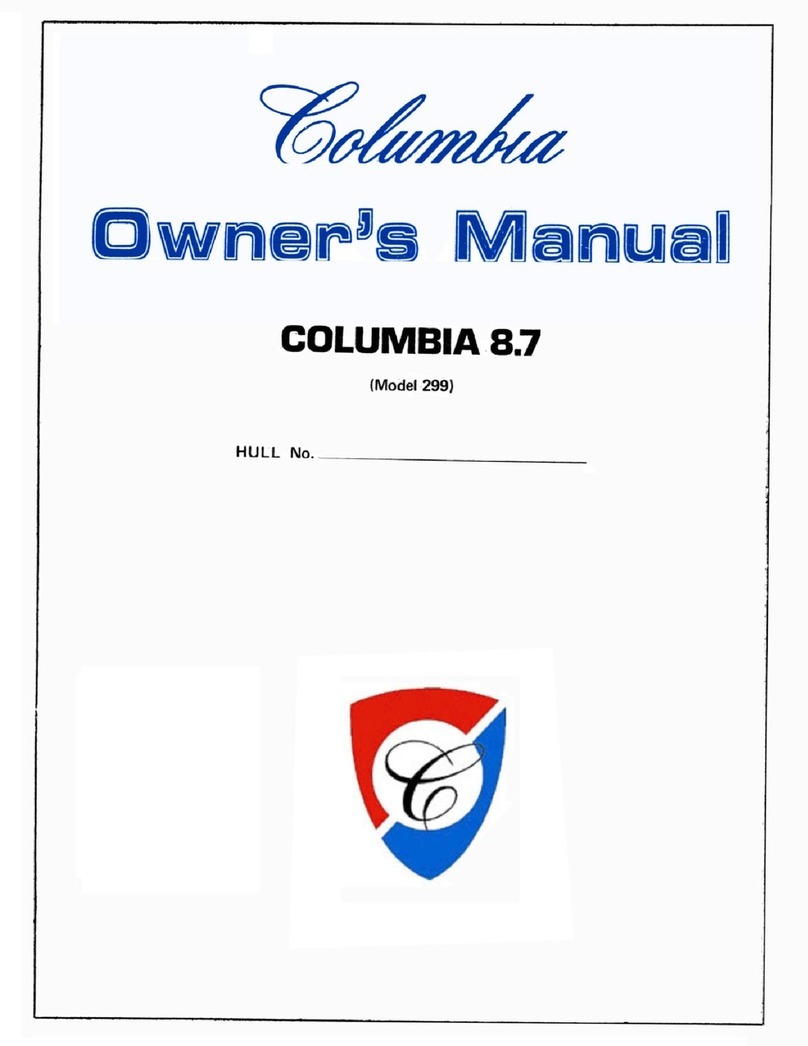
Whittaker
Whittaker Columbia 8.7 owner's manual
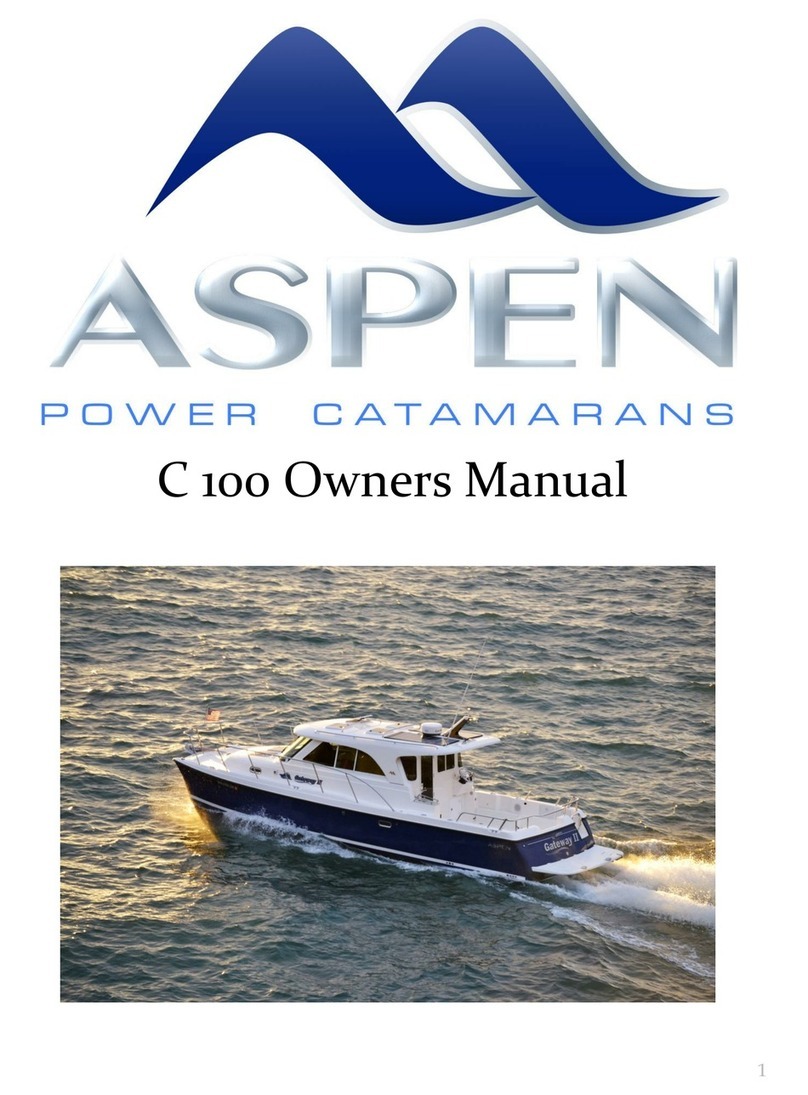
Aspen
Aspen C 100 owner's manual
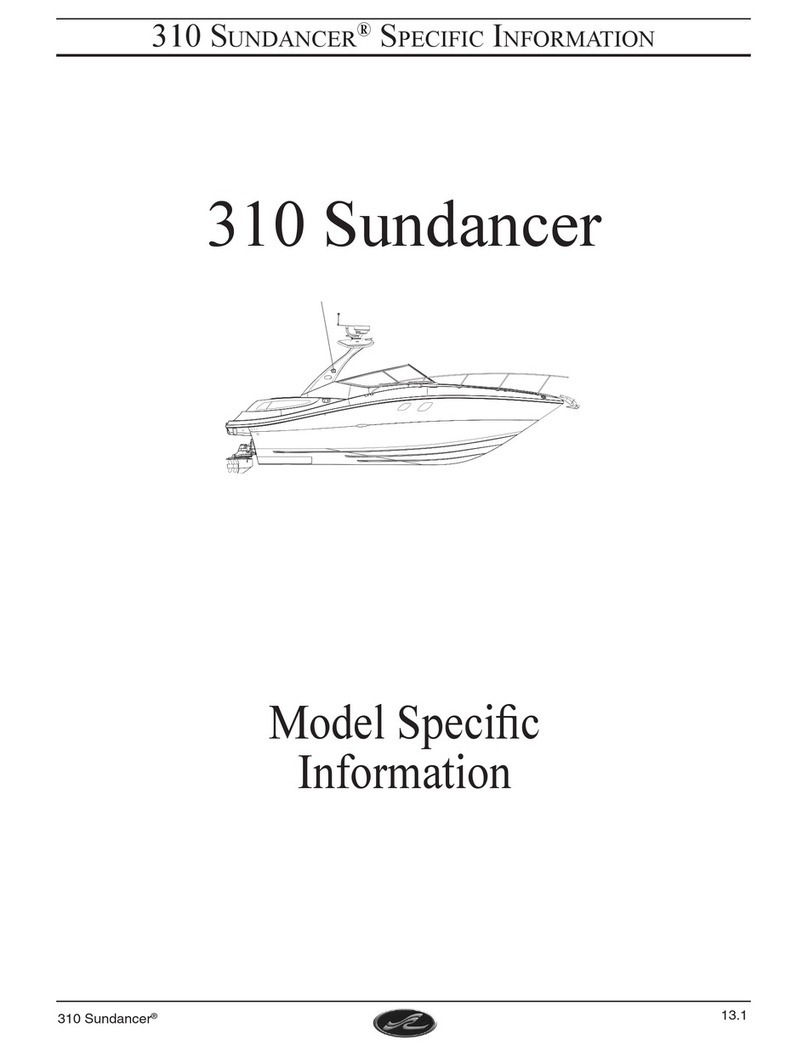
Sea Ray
Sea Ray 310 Sundancer Specific information
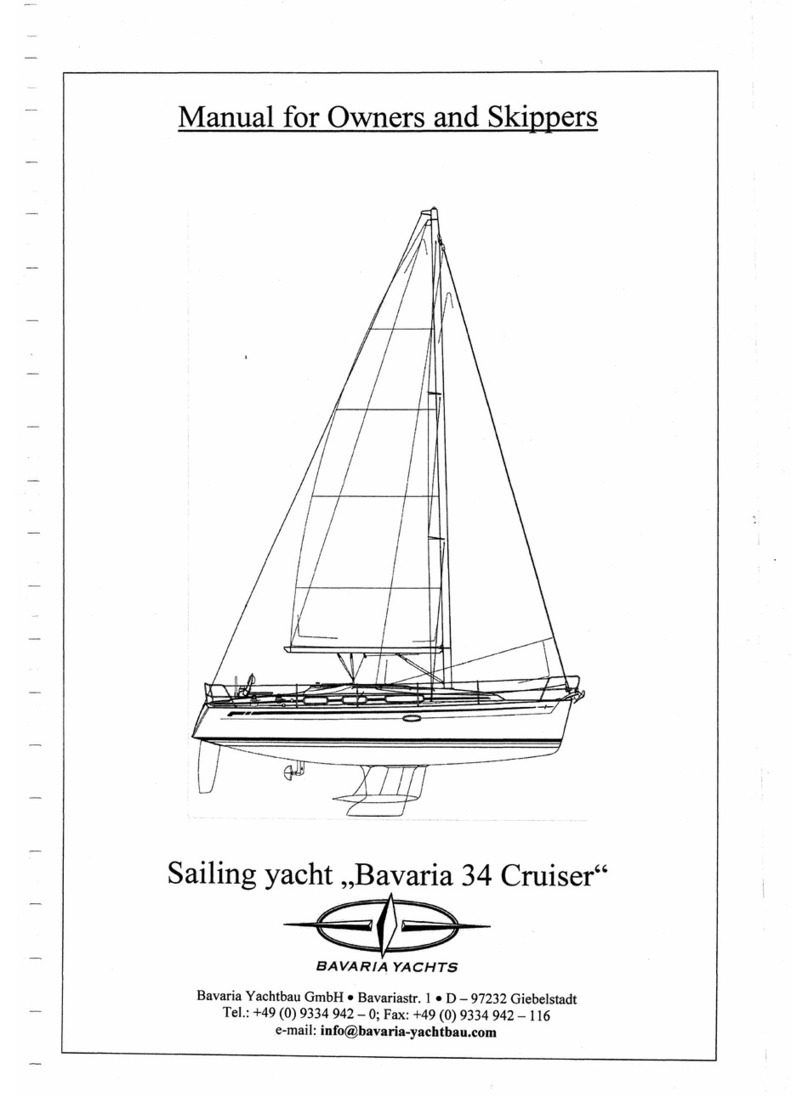
Bavaria Yachts
Bavaria Yachts 34 Cruiser Manual for owners and skippers

Carver Yachts
Carver Yachts 36 SEDAN owner's guide

Cobalt Digital Inc
Cobalt Digital Inc 276 bowrider owner's manual

